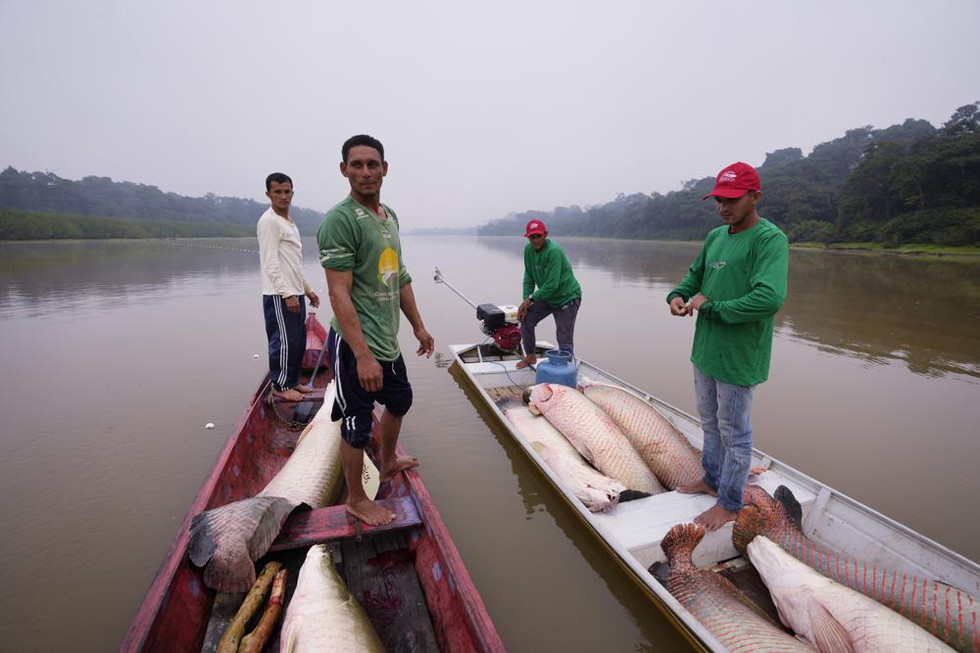
About:
- It can weigh up to 200 kilos (440 pounds), by far the largest of 2,300 known fish species in the Amazon.
- It is found primarily in floodplain lakes across the Amazon basin, including the region of Medio Jurua.
- It is one of the few fish species in the world that surfaces to breathe. It does that with a big splash, flashing its red tail out of the water.
- The giant fish not so long ago nearly vanished from Jurua, due to unregulated fishing.
- The illegal and unsustainable fishing left river and Indigenous communities struggling to catch their staple food.
- And it left pirarucu designated as threatened with extinction, unless trade in the fish is closely controlled by the Convention on International Trade in Endangered Species of Wild Fauna and Flora.
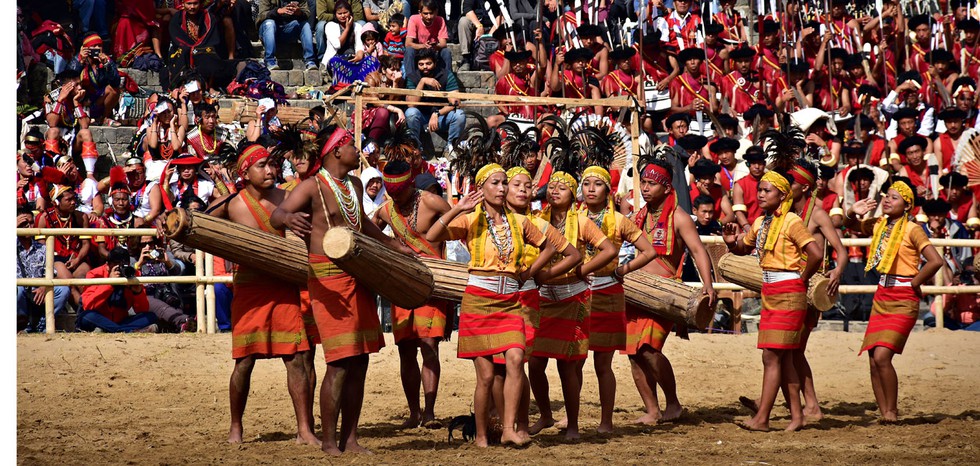
About:
- The Wangala Festival, also known as the 100 drum festival is celebrated with much zeal and enthusiasm in India’s north-eastern state of Meghalaya.
- Celebrated since 1976, it’s the most important festival of the Garo tribe and attracts a lot of tourists.
- During the Wangala, tribals offer sacrifices to please their deity Saljong, the Sun God.
- It marks the end of the long harvest season.
- The celebration also signifies the end of a long toil period in the field for the Garo tribe before the start of the winters.
- The first day of the festival is celebrated with a ceremony called Ragula which is performed in the house of the village’s chief.
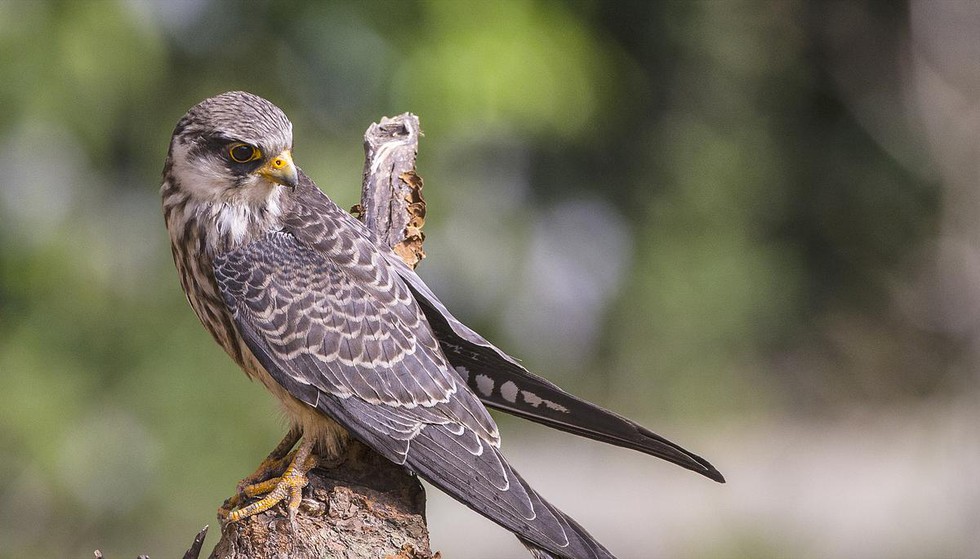
About:
- It is the first avian documentation exercise taken by Nagaland to go beyond Amur falcons.
- The event is being held during the Tokhü Emong post-harvest festival of the Lotha Nagas to spread awareness about Nagaland’s bird diversity.
- This event is being organised in collaboration with the Wokha Forest Division and the Divisional Management Unit, Nagaland Forest Management Project (NFMP), Wokha, and Bird Count India.
- The TEBC falls within the Salim Ali Bird Count, a nationwide event conducted by the Bombay Natural History Society.
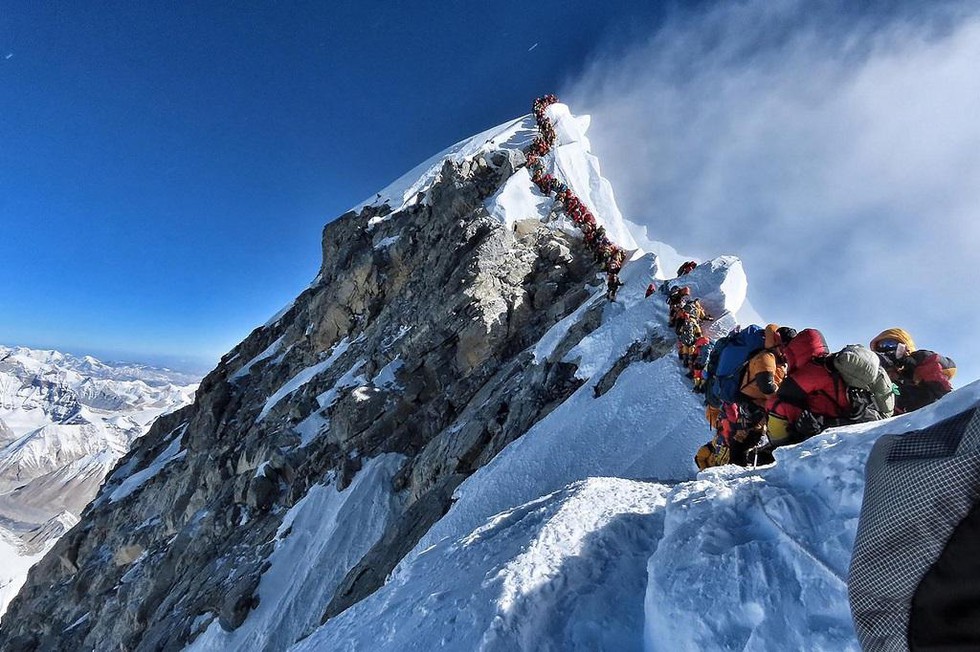
About:
- The study said it was still possible to save the other two-thirds if the rise in global temperature did not exceed 1.5°C compared to the pre-industrial era.
- In addition to drastically reduced carbon emissions, the UNESCO is advocating for the creation of a new international fund for glacier monitoring and preservation.
- Such a fund would support comprehensive research, promote exchange networks between all stakeholders and implement early warning and disaster risk reduction measures, the study said.
- Half of humanity depends directly or indirectly on glaciers as their water source for domestic use, agriculture, and power.
- Glaciers are also pillars of biodiversity, feeding many ecosystems.
- This study highlights the urgent need to cut greenhouse gas emissions and invest in nature-based solutions, which can help mitigate climate change.
- As many as 50 UNESCO World Heritage sites are home to glaciers, representing almost 10% of the Earth’s total glacierised area.
- The UNESCO study, in partnership with the International Union for Conservation of Nature (IUCN), showed that these glaciers have been retreating at an accelerated rate since 2000 due to CO2 emissions, which are warming temperatures.
- They are currently losing 58 billion tonne of ice every year — equivalent to the combined annual water use of France and Spain — and are responsible for nearly 5% of observed global sea level rise.
UNESCO World Heritage Sites:
- A World Heritage Site (WHS) is a landmark or area with legal protection by an international convention administered by the UNESCO under the UNESCO World Heritage Convention, established in 1972.
- These sites are designated by UNESCO for having cultural, historical, scientific or other forms of significance.
- The sites, classified as cultural, natural and mixed (meeting both cultural and natural criteria) heritage around the world, are considered to be of outstanding value to humanity.

About:
- The skeleton is of Bellairsia gracilis, a primitive squamate.
- Squamates are a group of reptiles that includes more than 10,000 living species descended from a shared common ancestor that lived 240 MYA.
- The fossil may improve our understanding of the anatomical transformations that led to the establishment of the body plan of reptiles such as modern lizards.
- If the anatomical interpretation is correct, then primitive squamates survived for tens of millions of years after the first lizards and snakes evolved and lived alongside them.

About:
What is the size of the NRI electorate?
- According to estimates, India has the largest diaspora population, with nearly 1.35 crore non-resident Indians spread across the globe.
- Many of them are in the Gulf countries, the U.S. and the U.K.
- In the 2019 Lok Sabha elections, 99,844 NRIs registered and 25,606 electors turned up to vote, with a majority hailing from Kerala (25,534).
- In the 2014 Parliamentary elections, 11,846 NRIs registered and only a fraction turned up to vote.
- Of the registered overseas electors, 90% belonged to Kerala. Others registered are from Gujarat, Punjab, and Tamil Nadu among other States.
- A major reason for low NRI registration and voting despite India amending the Representation of the People Act in 2010 to enable eligible NRIs who had stayed abroad beyond six months to vote is the condition that they have to visit the polling booth in person.
What has the government done so far?
- Since the in-person proviso of the amended Act discouraged many, petitions were filed in the Supreme Court between 2013 and 2014 by NRIs.
- The Election Commission of India (ECI) formed a Committee in 2014 on the Court’s direction to explore the options for overseas electors.
- The committee narrowed it down to two remote voting options —
- e-postal ballot and
- proxy voting.
- Electronically Transmitted Postal Ballot System (ETPBS):
- The Electronically Transmitted Postal Ballot System (ETPBS) involves the NRI voter sending an application to the returning officer in person or online.
- The returning officer will send the ballot electronically.
- The voter can then register their mandate on the ballot printout and send it back with an attested declaration.
- The voter will either send the ballot by ordinary post or drop it at an Indian Embassy where it would be segregated and posted.
- Proxy voting:
- Proxy voting, meanwhile, enables voters to appoint proxies to vote on their behalf.
- Both ETPBS and proxy voting are currently available to only service voters, like those in the armed forces or diplomatic missions.
- In its report, the ECI said proxy voting would be a “convenient” and “doable” method.
- In 2017, however, the government introduced a Bill to amend the Representation of People Act to remove the condition of in-person voting for NRIs and enable them to vote through proxies.
- The Bill was passed in the Lok Sabha in 2018 but never introduced in the Upper House, eventually lapsing with the 16th Lok Sabha.
- In 2020, the ECI wrote to the Law Ministry that it was “technically and administratively ready” to facilitate ETPBS for NRIs in the 2021 Assembly elections in five States but the External Affairs Ministry flagged “huge logistical challenges” relating to identity verification of voters, absence of polling agents, the burden on embassy staff etc.
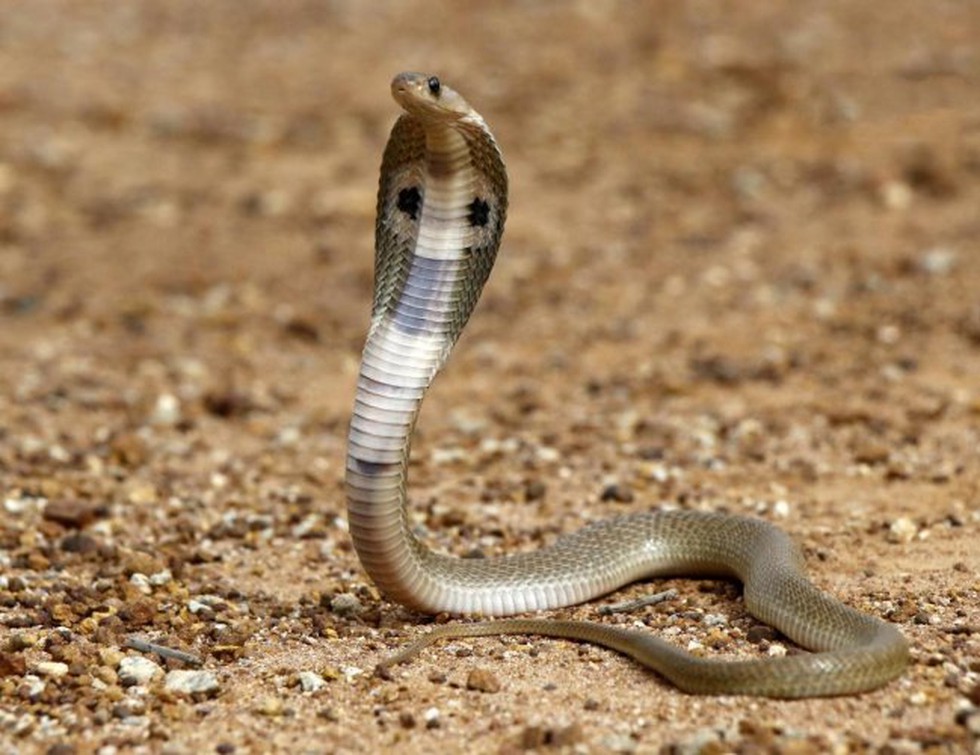
About:
- The study used data from verbal autopsy and vital statistics (civil registration) to estimate snakebite deaths from the Global Burden of Disease 2019 study.
- The global estimate of deaths due to snakebite comes 14 years after the previous one in 2008 and provides a more robust estimate.
- Snakebite (a neglected tropical disease) is a public health problem in India and many other low- and middle-income countries has been long known.
- Within India, Uttar Pradesh has the highest number of deaths, estimated to be up to 16,100, followed by Madhya Pradesh (up to 5,790 deaths), and Rajasthan (up to 5,230 deaths).
- The study estimated that the age-standardised death rate (which accounts for different age-structures in different countries, thus allowing comparison between countries) in India, at 4.0 per 1,00,000, is also among the highest globally, and many times over than the global figure of 0.8 deaths per 1,00,000.
- Only Somalia has a higher age-standardised death rate than India at 4.5 per 1,00,000.
- Within India, Chhattisgarh, Uttar Pradesh, and Rajasthan have even higher age-standardised death rates, at 6.5, 6.0, and 5.8 per 1,00,000, respectively.
Treatment:
- Anti-snake venom (ASV) are effective treatments to prevent or reverse most of its harmful effects.
- Steps by WHO:
- In June 2017, WHO added snakebite envenoming to its priority list of neglected tropical diseases (NTDs).
- Anti-snake venom (ASV) is included in the WHO Essential Medicines List.

About:
- Malabar is a multilateral naval exercise that began in 1992 as a bilateral exercise between the navy fleets of India and the United States.
- It includes simulated war games and combat manoeuvres.
- Since 2007, MALABAR has been held alternatively off Indian Coast and in the Western Pacific.
- The exercise has been held every year since 2002 (there was a gap after the 1992, 1995, and 1996 editions due to India's nuclear testing).
- It was expanded into a trilateral format with the inclusion of Japan in 2015.
- Currently, the Malabar exercise is among the navies of India, Japan, the US and Australia.

About:
- ‘Odd-even’ was first introduced in 2016 by the AAP government to control vehicular pollution and bring down increasing particulate matter levels.
- Under it, private vehicles with registration plates ending in odd numbers could ply on odd dates, and even numbers on even dates.
- Studies and research done on its impact in Delhi suggest positive results — from reduction in congestion to a slight drop in pollution levels and consequent improvement in air quality.
- According to a study done by Delhi Technological University (DTU) published in 2016, when the scheme was implemented for a roughly two-week period, concentration of PM 2.5 and PM 1 saw a drop.
- Studies have also shown that on an average, there was a reduction in PM 2.5 of 5.73 per cent and 4.70 per cent in PM 1 levels.

About:
Governor’s appointment, removal:
- Article 155 and 156: Under Article 155 and 156 of the Constitution, a Governor is appointed by the President and holds office “during the pleasure of the President”.
- If this pleasure is withdrawn before completion of the five-year term, the Governor has to step down.
- As the President works on the aid and advice of the Prime Minister and the council of ministers, in effect, the Governor can be appointed and removed by the central government.
- Thus, a Governor is a representative of the Union government in states.
- Article 163: Article 163 of the Constitution says the Governor will normally be aided and advised by the Council of Ministers except in those functions which require his discretion.
- While the Governor’s duties and responsibilities lie in a particular state, there is no provision for impeaching the Governor.
Disagreements:
- There are no provisions laid down in the Constitution for the manner in which the Governor and the state must engage publicly when there is a difference of opinion.
- The management of differences has traditionally been guided by respect for each other’s boundaries.
Cases:
- Since the Governor holds office “on the pleasure of the President”, questions have been raised time and again on whether the Governor has any security of tenure, and if the President is obligated to show reasons for recalling a Governor.
- In Surya Narain Choudhary vs Union of India (1981), the Rajasthan High Court held that the pleasure of the President was not justiciable, the Governor had no security of tenure and can be removed at any time by the President withdrawing pleasure.
- In BP Singhal vs Union of India (2010), the Supreme Court elaborated on the pleasure doctrine. It upheld that “no limitations or restrictions are placed on the ‘at pleasure’ doctrine”, but that “does not dispense with the need for a cause for withdrawal of the pleasure”.
- The President can remove the Governor from office “at any time without assigning any reason and without giving any opportunity to show cause”, the power to remove can’t be exercised in an “arbitrary, capricious or unreasonable manner”.





























































































































































.png)
.png)
.png)
.png)
.png)


.png)
.png)
.png)





.png)
.png)






.png)
.png)
.png)
.png)
.png)
.png)
.png)
.png)
.png)

.png)







.png)
.png)


.png)
.png)
.png)


.png)

.png)
.png)





.jpg)

.png)
.png)


.png)

.png)
.png)
.png)

.jpg)

.jpg)


.png)

.png)
.png)
.png)
.png)
.png)
.png)
.png)
.png)
.png)
.png)




.png)

.png)





.png)
.png)
.png)
.png)
.png)
.png)
.png)
.png)
.png)
.png)
.jpg)
.jpg)

.png)
.png)
.png)
.png)
.png)
.png)
.png)
.png)
.png)
.png)
.png)
.png)
.png)
.png)
.png)
.png)
.png)
.png)
.png)
.png)
.png)
.png)



.png)
.png)

.jpg)
.jpg)


.jpg)
.jpg)
.jpg)
.jpg)
.jpg)

.jpg)








.jpg)
.jpg)
.jpg)
.jpg)
.jpg)

















.jpg)
.jpg)







.jpg)


















.jpg)
.jpg)



























































































.jpg)
.jpg)


























.jpg)

.jpg)










.jpg)








.jpg)




.jpg)










.jpg)


















.jpg)












































.jpg)














.jpg)
.jpg)
.jpg)





.jpg)

.jpg)
.jpg)





































































.jpg)


































.jpg)
.jpg)
















































.jpg)












.jpg)


.jpg)




.jpg)
.jpg)
.jpg)

.jpg)
.jpg)
.jpg)
.jpg)

.jpg)
.jpg)
.jpg)

.jpg)
.jpg)
.jpg)
.jpg)
.jpg)
.jpg)
.jpg)
.jpg)

.jpg)


.jpg)
.jpg)
.jpg)
.jpg)
.jpg)
.jpg)
.jpg)
.jpg)
.jpg)
.jpg)











.jpg)
.jpg)





.jpg)
.jpg)
.jpg)
























.jpg)
























.jpg)









.jpg)
.jpg)







.jpg)
.jpg)









































.jpg)
.jpg)
.jpg)
.jpg)
.jpg)

.jpg)
.jpg)
.jpg)
.jpg)
.jpg)


.jpg)
.jpg)
.jpg)
.jpg)
.jpg)

.jpg)
.jpg)
.jpg)
.jpg)
.jpg)
.jpg)
.jpg)
.jpg)
.jpg)
.jpg)
.png)

.png)
.png)

.png)
.png)
.png)
.png)


.jpg)
.jpg)

.jpg)
.jpg)
.jpg)

.png)
.png)
.png)
.png)
.png)
.png)
.png)

.png)
.png)
.png)
.png)
.png)
.png)
.png)
.png)
.png)
.png)





































































-min.png)



.png)




.png)








































